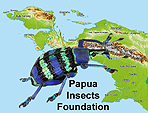

Papua-Insects.nl
The Papua Insects Foundation
The Asmat Lowland Area
South of the Central Mountain Range of New Guinea is a large and wide area of lowland. It was formed by sedimental deposition for millions of years ago. This area is crossed by numerous rivers and river deltas, forming swamps, wetlands and mangrove forests. The southern part of the coastal area is better known as the Casuarina Coast. The northern part of the area, bordered by the Sudirman and Jayawijaya Mountains, is a part of the Lorentz National Reserve, an important protected area for wildlife.
Of course the Asmat region is famous from the historical and cultural traditions. The woodcarvings of the shields and ornaments are world famous and very popular with tourists and collectors. The historical habits of cannibalism and other rituals is fascinating and still a subject to everybody's imagination. It is still believed that the famous Michael Clark Rockefeller, he was the youngest son of New York Governor (later Vice President) Nelson Aldrich Rockefeller, who dissappeared in this area on 17th November 1961, either drowned or was attacked by a shark or crocodile, but most favourite in the media was the believe that he was killed and eaten by local Asmat people as a revenge of a killing party of the Dutch patrols in 1958. The story goes that only his glasses were found in the forest near the place where he should have come to land.
Some of the most famous biological expeditions started in this area, like the three Dutch South New Guinea Expeditions and the English South New Guinea Expeditions, among which the Wollaston Expedition is probably the most famous and successful one. Collected material of these expeditions are stored in the natural history museums of London (BMNH), Amsterdam (ZMAN) and Leiden (RMNH).
The most important town in the area is Timika, nowadays with a busy transit airport. It is also the entrance to the commercial Freeport Mine in Tembagapura in the north. Secondly important is Agats, the actual capital city of the Asmat. In the wide area are many smaller villages, with or without airstrips, some only reachable by small boats.
Base of map by onearth.jpl.nasa.gov (modified with geographic names by Papua-Insects)
for an empty map with clear view click here
Entomological expeditions